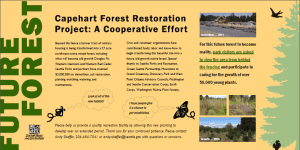

Naturalist and restoration volunteer David Hutchinson stands at the site of a future forest in Discovery Park.
Joni Mitchell once lamented, “They paved paradise and put up a parking lot.” At Seattle Parks and Recreation we’re trying to do just the opposite. But we need your cooperation.
In 2010, the City of Seattle purchased the Capehart Parcel in Discovery Park for $11.1 million when the Navy decided to move its military personnel closer to its Everett base. There were 66 houses on the site which totaled nearly 30 acres. 
Discovery Park restoration volunteers had been eyeing the site for a long time. “There were few remaining native conifers in the park and the bulk of the forest trees were deciduous, like Red Alder and Big-leaf Maple,” Naturalist and restoration volunteer David Hutchinson said. “Most of them were in the last stages of their life. We felt it would be good to start a new coniferous old-growth native forest, some place where a Marbled Murrelet would be happy to nest in about 500 years.”
In July 2010, the houses were demolished. The City partnered with a local contractor to remove and recycle the remaining infrastructure like old roads, foundations and utilities and plant 12,000 trees. In March 2012, the remaining restoration work was handed to Seattle Parks and the Green Seattle Partnership.
Since then, there have been many additional plantings of coniferous and deciduous trees, shrubs and some ground covers, making the plant total in the area more than 50,000. The site has already become home to many birds, butterflies and a variety of bee species.
As of spring 2015, the Capehart forest has been fenced off to accommodate a recovery and maintenance phase. During this time, Green Seattle Partnership and other volunteers will be watering the plants, weeding invasives and thinning some alders to allow for conifers’ growth. In this stage, shrub thickets and brush piles will also be created, producing habitat and winter cover for a variety of animals, especially birds.
Seattle Parks is asking for the public’s support and cooperation to not enter the fenced-off area to allow the forest to grow and flourish. Park visitors are asked to view the area from outside the fencing and participate in caring for the growth of more than 50,000 young plants.
For more information on the Capehart Forest Restoration Project, please visit http://www.seattle.gov/parks/projects/discovery/capehart/.